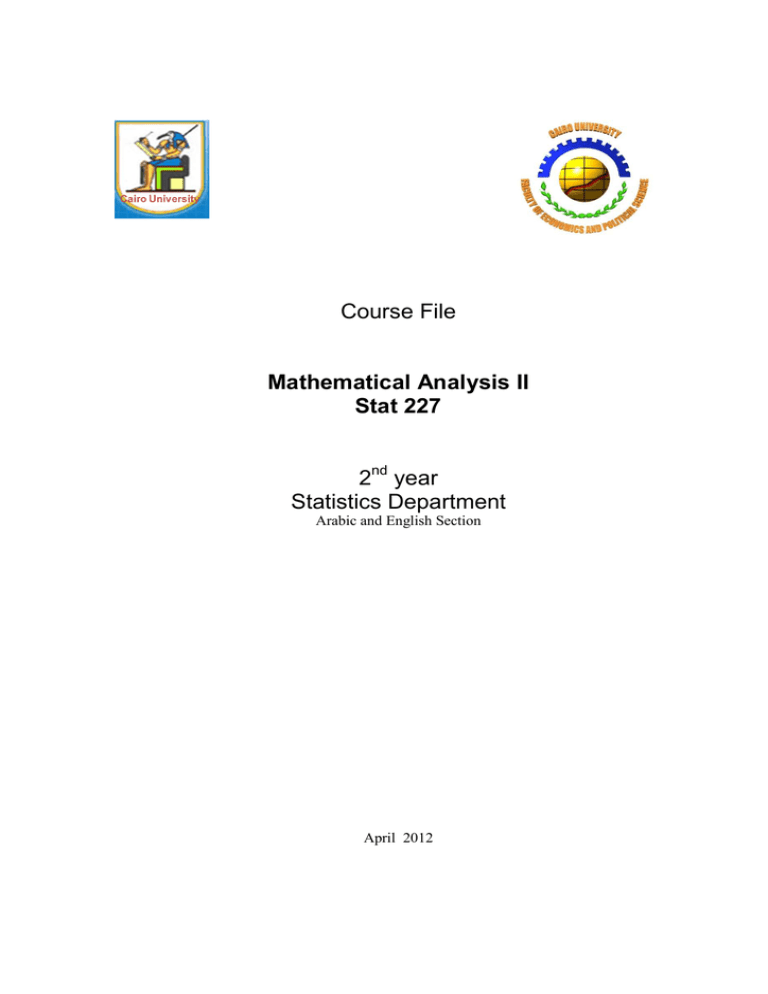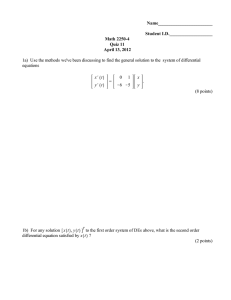
Course File
Mathematical Analysis II
Stat 227
2nd year
Statistics Department
Arabic and English Section
April 2012
Mathematical Analysis II
Course Code: STAT 227
Second-year statistics
Course Background Information
This course is introduced for students of the second year, statistics major, in the
second semester of the academic year. The prerequisites of this course are:
• Mathematical Analysis I (STAT 226)
Course Objectives:
This course aims to convey to the student a sense of the utility of differential and integral
calculus of more than one variable functions in the real life of modern society. It helps the
student to acquire some important mathematical skills needed for understanding the less
technical subjects and performing well as economists or business analysts. The course
provides students with a solid foundation in more than one-variable differential and integral
calculus, modeling and solving differential and difference equations. It covers partial
differentiation, extreme values, multiple integration, differential and difference equations. All
the standard techniques, theorems and basic applications are covered as well.
Intended Learning Outcomes
1) Knowledge and Understanding
Students’ recognition of the:
-
Functions of several variables and their applications
-
Behavior of these functions (limits and continuity)
-
Partial differentiation for these functions
-
The total differential
-
Maxima and minima (with/without constraints) of these functions
-
Applications of maxima and minima
-
Meaning of multiple integrals geometrically and its application in real life.
-
Determining the area or solid of integration (if possible)
-
Method of solving and calculating multiple integrals.
-
Definition of a differential equation.
-
Types of simple differential equations and their solutions.
-
Definition of a difference equation.
1
-
Types of simple difference equations and their solutions.
-
Real Economic and Business applications to all of the above.
2) Intellectual Skills
Developing students’ abilities to:
-
Describe the behavior of some functions in several variables.
-
Determine the partial rate of change for functions in several variables.
-
Locate the maximum and minimum values for functions in several variables.
-
Compare between different (more than two dimensional) shapes of solids, by
graphing the integrand or a part of it (integration limits).
-
Describe the meaning of the result or solution of the integration from application
point of view whenever possible.
-
Determine the
second,..).
-
Compare different types of differential equations and difference equations.
-
Solve different types of differential equations and difference equations.
-
Think how to approach and solve real applications mathematically.
proper
solving
direction
and
order
(for
which
variable
first,
3) Professional Skills
Developing students’ abilities to
-
Describe practical problems in a sound mathematical solvable model.
-
Use different mathematical models for analyzing and solving real life and job
problems.
-
Interpret mathematical descriptions and solutions by identifying significant
relations and reporting the results of their analysis in a clear, simple and
accurate way.
-
Work within a team, that involves in problem solving using a logical systematic
procedures.
2
Course Content
Subject
1. Analysis of Functions in Several variables
1.1. Functions of Several Variables
1.2. Limits and Continuity in Two Variables
1.3. Partial Derivatives
1.4. Total Differential
1.5. Maximum and Minimum Values
1.6. Constrained Maximum and Minimum Values
1.7. Economic and Business Applications
Number of teaching hours
(10.5)
1.5
1.5
1.5
1.5
1.5
1.5
1.5
2. Multiple and Double Integrals
(16.5)
3
1.5
1.5
1.5
1.5
3
1.5
1.5
1.5
2.1. Introduction about Double Integral
2.2. Double Integrals Over a Rectangular and General Regions
2.3. Geometric Applications (Area and Volume)
2.4. Evaluation of Double Integrals
2.5. Reversing the order of integration
2.6. Statistical Applications to Double integrals
2.7. Double Integrals Over Polar Coordinates
2.8. Change of variables in double integrals
2.9. General Problems and Triple Integrals
3. Differential Equations
3.1. Definition, type, order and degree of Differential Equations
3.2. Solution of first order and first degree ( SeparableHomogeneous - Exact- Linear)
3.3. General Differential Economic Models and Applications
(9)
1.5
6
4. Difference Equations
4.1. Definition, type and order of Difference Equations
4.2. Solution of First-order Linear Difference Equations
4.3. Economic and Business Applications
(6)
1.5
3
1.5
Total Teaching hours
42
3
1.5
Detailed Course Outline (Tentative)
Lecture no.
Subject
1. Analysis of Functions in Several variables
1
Course Objectives, Outline and Functions of Several
Variables
2
Limits and Continuity in Two Variables
3
Partial Derivatives
4
Total Differential
5
Maximum and Minimum Values
6
Constrained Maximum and Minimum Values
7
Economic and Business Applications
2. Multiple and Double Integrals
8
Quick Single Integral Rules Review
Double Integral as Limit of a Riemann Sums.
9
Graphs and Determination of Integral’s Area.
10
Calculation of Double Integrals Over Different Areas.
11
Double Integrals as Areas and Volumes.
12
General Double Integral Problems.
13
Reversing the Order of Integration.
14
Bivariate Probability Calculations.
15
Mean-Value and Mass Theorems.
16
Double Integrals Over Polar Coordinates.
17
Change of Variables in Double Integrals.
18
General Problems and Triple Integrals
3. Differential Equations
19
Introduction about Differential and Difference
Modeling.
Type, Order and Degree of Differential Equations.
4
Lecture no.
Subject
20
The Concept of Solving Differential Equations
21
Solving Separable Differential Equations and
Solving Homogenous Differential Equations.
22
Solving Exact Differential Equations.
23
Solving Linear Differential Equations.
24
General Differential Economic Models and
Applications.
4. Difference Equations
25
Definition, Order and The Concept of Solving a
Difference Equation.
26
Solving First Order Linear Difference Equations
(Constant Coefficients).
The Behavior of Solutions On The Long-Run.
27
Solving First Order Linear Difference Equations
(Variable Coefficients).
The Behavior of Solutions On The Long-Run.
28
Economic and Business Applications.
Teaching and Learning Methods
Lectures: Lectures are the main teaching method. For each topic basic concepts and
theoretical backgrounds are presented and formulas are derived. Applications of these
formulas are illustrated with many different examples.
Discussions: Lectures are interspersed with discussion and questions. Once a topic is
covered students are encouraged to discuss their questions that evolve with their colleagues
5
and the lecturer (how to approach the problem, which technique is the most suitable and how
it can be performed).
Group Problems: At the end of each topic (approximately every three weeks) the lecturer
refers to a problem or two for each three or four students, which they can work together to
solve. Then by the end of one class the lecturer can randomly pick two students from the
group to explain their solution, with the possibility of asking the other parties of the group in
the middle.
Problems and Exercises: These help students grasp the main ideas and practice the use of
the class techniques and methods .
Readings: as each topic is being presented during the lecture the lecturer refers the students
to different chapters/sections in the text book or references to elaborate on the topic, cover
more details and examples.
Text books and References
G. B. Thomas, Jr " Thomas (2010), Calculus, 12th edition, (International Edition), Boston:
Pearson Addison Wesley. (Main Text)
M. R. Spiegel, Calculus of Finite Difference and Differential Equations, Schaum's Outline
Series. McGraw-Hill Book Company.
Students Assessment
-
Quizzes: Three pop-quizzes are given throughout the term, two before and two
after the midterm. Each may contain a problem worth one mark.
-
Mid-term exam (contains problems and questions measuring knowledge and
understanding): evaluated from 7 marks. [See Model A in the annex].
-
Final exam. (contains problems, proofs, knowledge questions, and questions
measuring critical thinking): evaluated from 20 marks. [See Model B in the
annex].
6
Annex
A: Model Mid-term Exam
1. If a production function is given by
z 2 + 4 x 2 + 5 y 2 − 12 x y = 0 , where
z is the amount of output and x and y are the amounts of the inputs, then, using implicit
differentiation, find the marginal productivity of x and y and determine when they are
positive.
2. Suppose the production function is
16 z = 65 − 2 ( x − 5 ) 2 − 4 ( y − 4 ) 2
, where the unit prices of x
and y (under pure competition) are 8 and 4, respectively, and the unit price of the output
is 32. Determine the maximum profit.
f ( x , y ) = 5 x 2 + 6 y 2 − xy
x + 2 y = 24.
3. Find the maxima and minima (if any) of
subject to the constraint
4. Sketch the region of integration, then evaluate by reversing the order of the integration
2
I1 =
2
∫ ∫
2 y 2 S in ( x y ) dy dx
x =0 y =x
7
.
B: Model Final Exam
1. / A factory manufactures two types of heavy- duty machines in quantities x and y. The
joint-cost function is given by
f (x ,y )=x
2
+2y
2
− x y . To
minimize cost, how many machines of each type should be produced if there must be a
total of 8 machines.
2. If
(3 points)
u = (x + y ) ( x − y )1/ 2 , compute du.
(2 points)
3. / Drive the general solution for the first-order (linear in f ( y ) ) differential equation;
d f (y )
+ P (x ) f ( y ) = Q (x ) .
dx
1
4. / Evaluate the integration
1
(1 point)
y −x
∫ ∫ ∫ dz dy dx
x =0 y = x z =0
. What is your output represents?.
(2 points)
5. / Find the solution of the differential equation,
x = 1 & y = 1.
6. / Solve the difference equation,
2 x d y = (y 2 x 4 + y )d x
when
(2.5 points)
Y x +2 −4Y x = 9, if y0 = 0 & y1 =1.
(2.5 points)
7. / Solve the difference equation , 3Y x +1 − 2Y x −3 =0, if y0 =5. Determine the
behavior of the solution sequence and calculate the first 5 values of the solution
sequence.
(2.5 points)
8. / Regional population: If f (x , y ) = 100( y + 1), represents the population density
of a planar region on earth, where x and y are measured in miles, find the number
2
2
of people in the region bounded by the street curves, x = y & x = 2 y − y .
(3 points)
9. / If the interest rate is 100i% compounded continuously and A is the amount at any
time, then
dA
= i A . Drive the formula for calculating the balance at time t.
dt
(1.5 points)
8

